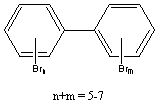
NTP Study Reports

NTP Study Reports
Home » Study Results & Research Projects » NTP Study Reports » All Long-Term Reports » Abstract for TR-244 - Polybrominated Biphenyl Mixture (Firemaster FF-1)

Chemical Formula: Unknown
Firemaster FF-1, a flame retardant composed of polybrominated biphenyls (PBB), was responsible for widespread environmental contamination and animal losses in Michigan starting in 1973. This study was undertaken to characterize the long-term toxic and carcinogenic potential of this PBB mixture in rats and mice of each sex. Fisher 344/N rats and B6C3F1 mice were given 125 oral doses of PBB over a 6-month period--0, 0.1, 0.3, 1.0, 3.0, or 10.0 mg/kg body weight/day (5 days/week).
A dose-related decrease in body weight gain was observed in both male and female rats and male mice, although there was no significant difference in food consumption. At the end of the 6-month exposure, there was a dose-dependent decrease in thymus weights in rats. The liver appeared to be the primary target organ. Dose-related hepatotoxic effects were characterized by a marked increase in liver weight, with accentuation of hepatic lobular markings. Microscopically, there was moderate to marked hepatocellular swelling, disorganization and single cell necrosis of hepatocytes, fatty infiltration, and bile duct proliferation. At the 6-month observation, atypical hepatocellular foci were observed at a low incidence in dosed rats and mice. Hepatic porphyrin levels were markedly increased in both rats and mice, excessively in females. Levels of porphyrin tended to decrease gradually, primarily in mice, following cessation of exposure. The significant decreases in serum thyroxine (T4) and triiodothyronine (T3) in rats suggest that PBB may interfere with thyroid hormone secretion.
Total serum protein was decreased in dose-related fashion in female rats primarily due to dose-related decreases in albumin. There was a significant increase in the serum levels of gamma glutamyl transpeptidase (GGTP) in female rats given 10.0 mg/kg of PBB. There was a dose-related decrease in serum glucose in female rats, a dose-related decrease in the serum triglyceride level in dosed male rats, except at the lowest dose (0.1 mg/kg), and a dose-related increase in the serum levels of cholesterol in both male and female rats.
Serum levels of GGTP were increased only in female mice given 10.0 mg/kg of PBB. There was a 5- to 6-fold increase in the activity of serum glutamic pyruvic transaminase (SGPT) in male and female mice in the 10.0 mg/kg groups. Serum enzyme activity of alkaline phosphate (AP) was also increased in mice given the highest dose of PBB. There was a significant dose-related increase in the serum levels of cholesterol in female mice, and the highest dose group was significantly greater than the control female mice. Serum glucose was significantly decreased in female mice administered 10.0 mg/kg of PBB.
To determine the carcinogenic potential of PBB, rats and mice dosed for 6 months were observed without exposure to PBB for an additional 23 or 24 months, respectively (lifetime observation). The dosing (0.3 mg/kg or higher dose levels) shortened the survival time in male rats, whereas no such effect was observed in dosed females. There was also evidence of shortened survival time in the 10.0 mg/kg PBB-dosed mice. A significantly higher incidence of atypical hepatocellular foci, neoplastic nodules, hepatocellular carcinomas, and cholangiocarcinomas was observed in dosed rats. The incidence of hepatocellular carcinoma was increased in both male and female mice (highest dose level) compared with control male and female mice. The incidence of hepatic neoplasms appeared to be dose dependent in rats and mice. Liver tumors were observed primarily in those groups of animals to which PBB was given in doses sufficient to induce readily observable hepatic toxicity.
Under the conditions of these studies, polybrominated biphenyl mixture (Firemaster FF-1) was carcinogenic for Fisher 344/N rats and B6C3F1 mice of each sex, inducing neoplastic nodules, hepatocellular carcinomas, and cholangiocarcinomas in rats and hepatocellular carcinomas in mice. Other toxicities included porphyrogenic effects and hepatotoxicity.
Levels of Evidence of Carcinogenicity: | ||
| Male Rats: | Positive | |
| Female Rats: | Positive | |
| Male Mice: | Positive | |
| Female Mice: | Positive | |
Synonym: Firemaster FF-1
Report Date: June 1983
Target Organs & Incidences from 2-year Studies
You may link to the full technical report in pdf format ( Note: A print ready copy of the document is presented in Portable Document Format (pdf) which requires the Acrobat Reader plug-in -- download a free copy of the reader.)
Web page last updated on October 14, 2004
The National Institute of Environmental Health Sciences is one of the National Institutes of Health within the U.S. Department of Health and Human Services. The National Toxicology Program is headquartered on the NIEHS campus in Research Triangle Park, NC.